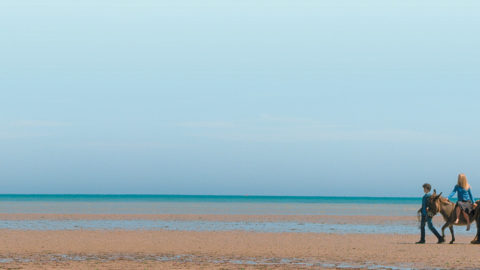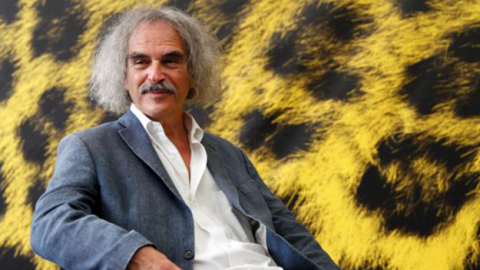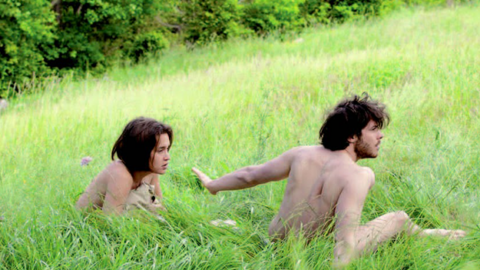Rendez-Vous: Salut les Jeunes Critiques
For the 23rd edition of their annual Rendez-Vous with French Cinema festival, the Film Society of Lincoln Center and UniFrance held a special essay contest called Salut les Jeunes Critiques, sponsored by Frenchly, inviting young critics to write about a film of their choosing from the lineup. The Grand Prize winner, receiving a free trip to Paris, is Amy Chabassier, who reviewed Léa Mysius’s Ava; the Second Prize winner, receiving a free TV5MONDE subscription for one year, is Daniel Witkin, who wrote on Eugène Green’s Waiting for the Barbarians. Both winners also receive a New Wave membership, which includes invitations to private screenings and events throughout the year at the Film Society of Lincoln Center.
Read both winning reviews below.
Grand Prize Winner
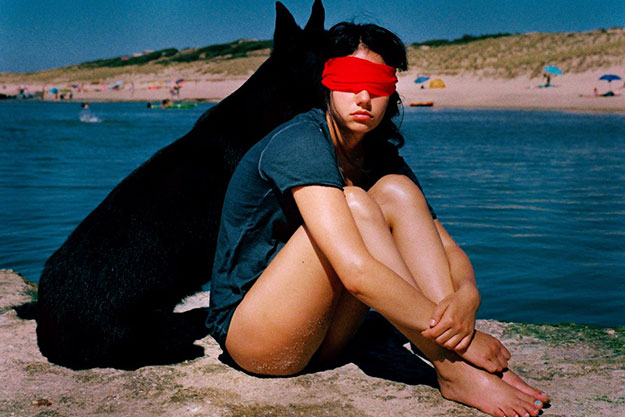
Ava by Amy Chabassier
Rendez-Vous with French Cinema this year brings us Léa Mysius’s debut feature film Ava, a bold coming-of-age story about 13-year-old Ava (Noée Abita in her first role), the summer she learns she will soon go blind.
The film’s introductory sequence of a lively colorful beach in prime summertime in southern France is interrupted by the sudden appearance of an ominous soundtrack and a wolf-like black dog. In contrast to the vibrant and richly saturated images around which it roams, the dog is makes us alert to darkness rather than light. Mysius reverses and overturns the notion of filmmaking and its possibilities here, as if endlessly proving that film can exist in the dark, too—all the more poignant considering the film is shot on 35mm, a medium largely necessitating a strong light source. Right from the start then, it is no longer the light of the sun and the colorful bathing suits that attract our eyes, but rather the dark black dog, and soon after, Ava, a somber character herself. Darkness shines brighter than light does, markedly evocative for a film about vision and the loss of it.
In its depiction of the freedom of life on the run, the film takes on a discernible resemblance to Godard’s Pierrot le fou (1965): Mysius’s characters turn into figures in the wild, their off-screen voices interspersed with fragmented scenes, emblematic of the rupture of a linear film construction. Ava and her fugitive love interest Juan (Juan Cano) paint their bodies with clay and steal from various nude beachgoers. Here the shots are nonlinear, montage becoming more evident (her use of split screens emphasizes this). The protagonists come into close proximity to Marianne and Ferdinand’s bandit figures, just as the narrative becomes fragmented like Godard’s, and the film’s montage made palpable.
They later travel through a deserted road where Amadou & Mariam’s song “Sabali” plays (Mali’s famous blind husband-and-wife duo). Although Mysius does not invoke a breaking of the fourth wall as Godard does, and is in no way as self-conscious as he is, she does impose a certain reflexivity. In this dancing sequence, Ava lets herself be seen: she no longer hides her body, and in turn looks too—her eyes no longer covered by a blindfold nor by the darkness behind which they cannot see. She turns more naked and self-conscious than in the film’s more literal nude shots. She is here no longer “somber and invisible” but becomes “bright and luminous” as she once describes Juan’s other love interest, yet (and this distinction is important) luminous through her darkness.
In this desolate space, the film adopts its more evocative image and meaning: it allows
for Ava to take up the film screen in a natural way, dancing freely in space. This deviation from narrative is conceivably one of the film’s most successful nuances—Mysius does not contrive to make any explicit and blaring allusions to Ava’s oncoming blindness. Instead, the camera focuses implicitly and renders an honest witnessing of a true moment. And perhaps most importantly, it allows for Ava herself to briefly experience a happy occurrence with her vision still intact. Through it, she is able to become more self-conscious of her being, of her coming of age, and hence also comes closer to an acknowledgment of her declining sight.
In its more allegorical scenes, such as a surrealist nightmare sequence, constant black shots, and imposed symbols alluding to darkness and blindness, Mysius is perhaps less strong. Ava emerges as more successful when Mysius offers us less help, urging us to slip into the film and decipher its meaning through an evasion from plot with an emphasis on transient moments, manifested montage, and a masterful use of colors and cinematography. The film thrives in those shots in which the story seems to unfold spontaneously through the life brought about by its largely nonprofessional actors, who fill up the screen with light and dark flickers and enable cinema’s inherent plot line to manifest itself—that of vision and the play with light.
Where brightness and color should take over our eyes’ attention, Mysius makes it so that darkness does so in Ava, as if playing with our own faculty of vision throughout the film—and ultimately playing with the nature of cinema as an agent no longer of light but a lack thereof.
Second Prize Winner
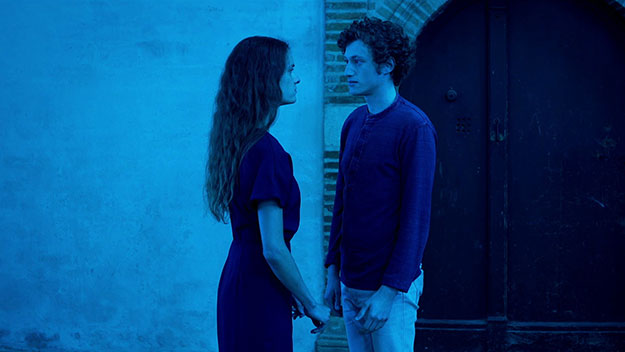
Waiting for the Barbarians by Daniel Witkin
It’s long been known that Europe is haunted by specters. The continent is home to a remarkable diversity of ghosts. The spirits of victims and perpetrators alike can be divined in museums, shopping arcades, or among ruins ancient or modern. The Ghost of Things to Come looms threateningly over the present, while the past recedes by the day into a faint but ubiquitous phantasmagoria.
The six primary characters in Waiting for the Barbarians, the new film by Eugène Green, are haunted as well. Fearing an imminent raid by the titular hordes, they seek refuge with a sorcerer and his wife; though for all their superstitions, they are nothing if not modern. We know them not by their names, but by their social roles: The Poet, the Bobo, the Bobelle, the Paintress, the Homeless Man, and the anti-Bobo. Despite their differences, they are united by a certain debilitating fear. The anti-Bobo is a politician who refuses to start his political party for fear of defeat, while the Paintress likens the act of working upon a canvas to committing a sexual violation. The feared forces are varyingly identified as Huns, Scythians, and “United States-ians,” though the characters’ true malady evidently lies within. As one of them says, “The barbarians only come when we wait for them.”
Eugène Green is a United States-ian, although fortunately he is no barbarian. On the contrary, the director is a steadfast advocate for a very specific idea of civilization. Green moved from New York to Paris in 1968 to study baroque theater, and his films often shine an affectionate light on the artistic masterworks of the past. Green is drawn to those pieces of art that through prodigious talent and sheer effort make the case that the human being does indeed contain the spark of the divine, such as the Borromini church that lent its name to his 2014 film, La Sapienza. Yet for all his erudition and technical precision, Green’s films themselves are remarkably humble and approachable.
An apostle of Robert Bresson, Green’s direction is highly formal. He is perhaps known above all for staging actors delivering their lines directly to the camera in a declamatory style, but as a student of theater and architecture, he also carefully depicts characters in their environment, whether a bury Parisian streetscape or a Roman chapel. He’s also a formidable wit, and his characters’ brief, declarative statements often take the form of deadpan one-liners.
It’s appropriate that Green’s movie prominently features a sorcerer. Like the alchemists who filled the courts of the baroque past that so fascinates the filmmaker, Green works in the murky, fertile liminal spaces between science and faith, the mind and the spirit. He seeks to transform one substance into another. The film’s introduction text sets this in plain text: “The reality of twelve actors and a small crew becomes a fiction expressing the reality of the world.” Like Bresson, his method is engineered to capture things that aren’t often made evident onscreen; in his case this includes the tangible quality of the human voice or sunlight streaming into a church courtyard.
Waiting for the Barbarians is an unabashedly didactic film, a sort of Better Living Through Anachronistic Theater. The film takes the shape of a journey from darkness into light. The characters first must relinquish their phones, then are released into obscurity to face their inner travails, or, in the case of the poet, to meet a nice girl, the sorcerer’s daughter, who just so happens to be a ghost. Here, Green heightens his usual minimalism, and the light in this vacuous region illuminates only what is essential: the faces of the characters and a well placed detail here and there. After the sorcerer delivers an analysis of some paintings in a church, the motley bunch is treated to a performance of excerpts from the medieval Arthurian romance Jaufre, in which the titular hero is brought back from the dead to dispatch a cruel tyrant. The sorcerer hopes that this experience will produce a sort of awakening in the characters.
Yet this is no art history lesson. Rather, it’s a film about resurrection, which appears in the film twice: as theater in the first case and rather more mysteriously in the second. In both cases, Green films the return to life without resorting to mysticism, finding it in moments of human connection, a shot of joined hands worthy of Bresson, and a moment of eye contact, no less tactile. Green might appear anachronistic, but he’s focused firmly on the present. He attempts to jolt his viewers into the realm of the living, to keep them from assuming a ghostly existence, and in this he is a vital and even a radical artist.



